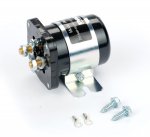Vicreo A Legarreta
Vicreo
Thanks...that is what I thought.
but I will recommend to use deep cycle or gel batteries, will not mix wet ( or flooded battery )with other type of battery
Thanks...that is what I thought.
Where is everyone getting trays to mount a second battery under the hood?
I have a 2009 Tacoma and there is definitely a place for a tray.
So if I'm using a CTEK controller instead of a solenoid do I still need an 80A fuse between the batteries and the controller?
I am currently using a switch actuated solenoid to send power to the battery I have in the bed of my truck. Sometimes I forget to turn it on or off. Would this survive being mounted in a truck?
I screwed up my post..............doh!
http://www.batterystuff.com/battery-products/switches/Bi303303.html
I want to replace my solenoid with this. Any issues with the unit?

More dumb questions! I finally got my solar mounted, and I am ready to start getting the isolation circuit put together. How many amps do starters really draw? I see the updates 200A fuses, does this mean the 200A solenoid would be ok for a self-jump? Found this one for 30 bucks cheaper...
http://amzn.com/B000CEBXRS
View attachment 174462
So, pair that with some nice large wire, some 200A ANL fuses and I'm good to go? Or do I go for the 500A version....gonna probably do a 3-way switch with on(auto + timer), off(disconnected), and on(self jump).
So my set-up is working great. Is there a way to show battery charge on one or both batteries? Is there a good mo it or system?
Thanks
Won't a volt meter just check how much juice it's producing? Is there a way to show te level of charge per battery? A volt meter is a great idea to make sure 2nd battery is
Being charged. Thanks
